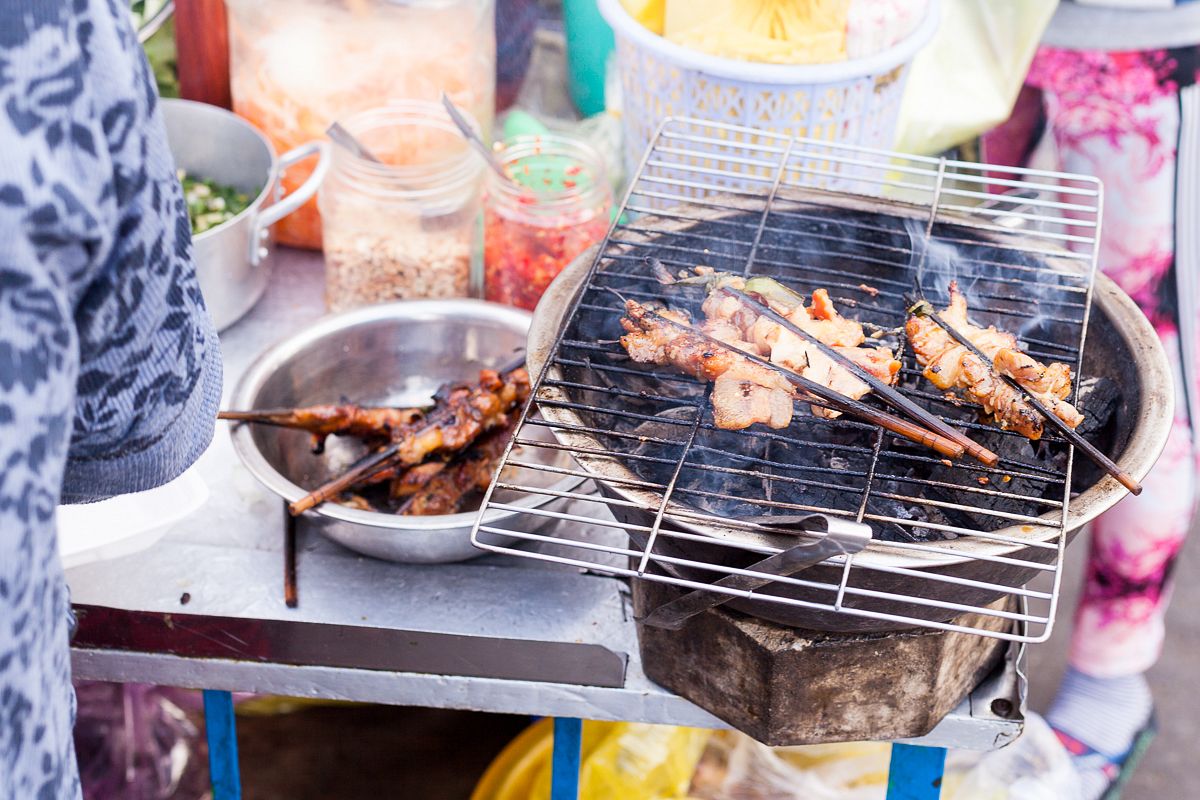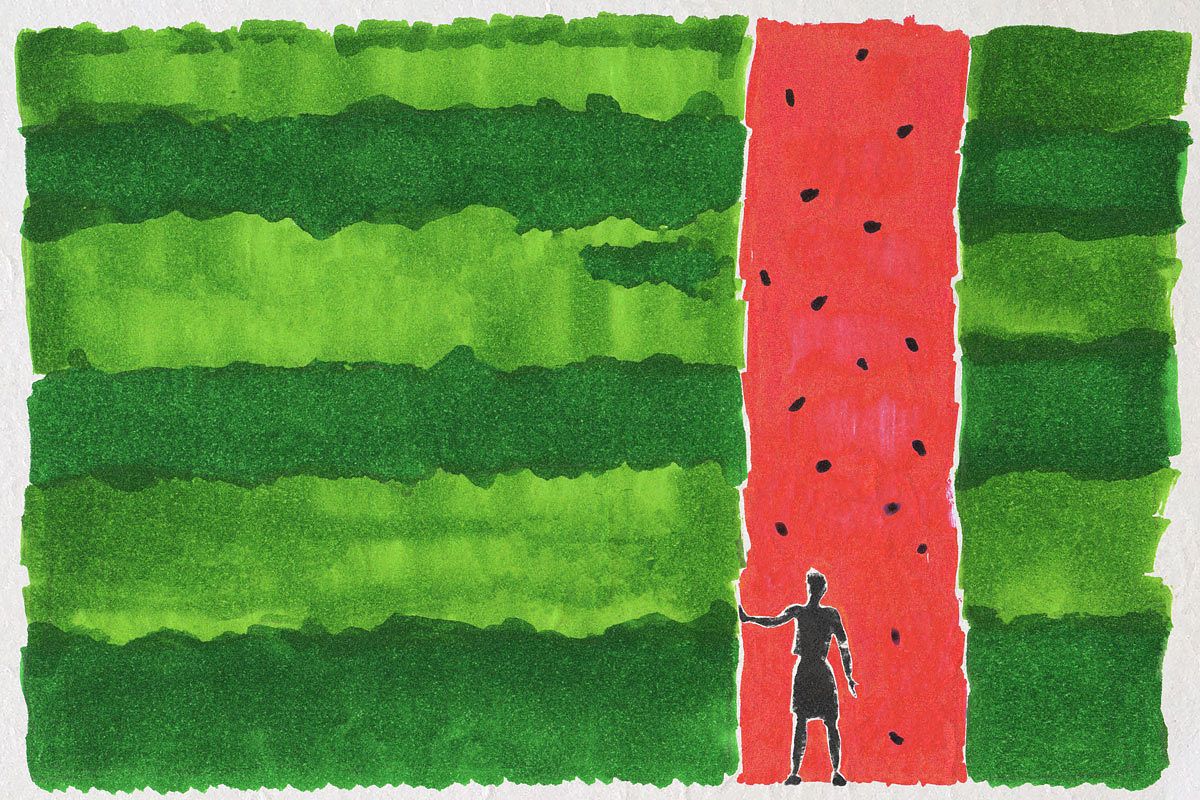“Never half-ass two things. Whole-ass one thing.” — Ron Swanson
It was a Tuesday like any other when Pizza 4P’s dropped the mắm tôm bomb on us. On March 5, the Japanese pizzeria chain announced on its Facebook page that it would start serving a special seasonal item in a select few restaurants in Saigon: a bún đậu mắm tôm pizza. A few days prior, rumors of the dish had already started brewing after an Instagram user posted a photo of the elusive dish on their Story. Screenshots of the post were passed around like leaked nude images of celebrities, inspiring a chorus of derisive comments at local meme mills. People were shocked, upset, intrigued, and aghast.
After the official announcement was unveiled, three separate people sent me the photo of the controversial pizza, all accompanied by quizzical emoticons. I am admittedly a Pizza 4P’s fan, and in my social circle here in Saigon, we have over time cultivated a casual 4P’s community where we would gather a few times a month to exchange pleasantries, sip on some wine, and rabidly devour burrata-themed products together.
In the face of this brand-new pizza invention, I was cautiously taken aback at best, and repulsed at worst, as just the thought of mixing shrimp paste and cheese in one bite drowns the butterflies in my stomach. A coworker outright refused to engage in the discussion when asked because he didn’t want to eat something “created just for the sake of viral marketing.” Others expressed interest in trying the bún đậu bomb, but we were pretty much in agreement that the world would be perfectly fine without it.

A set of bún đậu mắm tôm pizza with heaps of toppings. Photo by Michael Tatarski.
The daring decision by 4P’s to create a bún đậu-pizza fusion does precipitate some questions. The Japanese-Italian franchise has rarely been all that interested in marketing, and it doesn’t really have to: the media and word of mouth have done that for free. News of Vietnam’s latest farm-to-table pizzas has reached the Japan Times, New York Times and BBC. The bún đậu pizza is not the restaurant’s first foray into Vietnamese-western fusions either; back in 2018, it also launched a pizza-fied version of chả cá Lã Vọng, another Hanoian classic that has earned high praise from legendary food writer Vu Bang. Its other Japanese-Italian fusion dishes, such as the new gyudon pizza with beef and pickled ginger, are delectable.
For a hypothetical marketing stint, Frankenstein-ing bún đậu and pizza seems like a high-risk choice. The reception online has been mixed, judging by the passionate comments netizens left on the announcement’s Facebook post. Some were livid and demanded the closure of the chain, while more open-minded commenters seemed curious about the combination, albeit with some understandable smell-related trepidation. High-risk or not, the choice has undeniably yielded high-reward. Pizza 4P’s has been featured prominently in many local TV channels, newspapers and online media sources — I’m sitting here writing an article about the dish, after all.
Our order of bún đậu mắm tôm pizza arrived at the table without much fanfare. Its online notoriety has definitely preceded it because I was half-expecting the waitress to come with a gas mask and a hazmat suit. My first impression of it was the suspicious lack of mắm tôm aroma. Only by deliberately placing my nostrils inches from the crust did I catch a timid whisper of that distinctive fermented shrimp smell. The crust was the usual 4P’s staple, this time with minimal cheese and a jungle of bún đậu toppings. On a bed of fresh green tía tô leaves (shiso), there were slices of cooked pork, cubes of fried tofu, morsels of chả cốm (fried pork sausage with rice) and dollops of mắm tôm reduction. Finally, finely chopped chili, coriander and kinh giới — a fragrant herb — were sprinkled on top. The pizza also comes with a plate of accouterments: more mắm, two calamansi for that citrusy kick, and additional herbs.

A tray of bún đậu served at Hanoi's famous Bun Dau Hang Khay. Photo by Chris Humphrey.
The first time I had bún đậu mắm tôm was in 2004, made by a relative right in her backyard. The kitchen area greeted us with sizzling of the tofu, crisping up in a bath of hot grease as we spoke. Via two huge windows, the room opened into the backyard, a tapestry of light and shadows made animated by huge trees and their extensive canopy of leaves. In case you’re wondering what’s in a name, back then, bún đậu was just so: bún, đậu and mắm tôm — three ingredients, in addition to heaps of fresh herbs, make the most rudimentary of countryside dishes a memorable feast.
Bún đậu is a categorically northern dish, and it still is, but the line has faded significantly over the years. Now it’s all over Saigon while before, most of the time, it wasn't something commonly available at a restaurant, and someone had to make it for you at their home. Many attribute the establishment of Bún Đậu Cô Khàn in 2013, opened by social media personality Trang Khàn, as the impetus that accelerated the popularity of bún đậu in the south. Today a portion of bún đậu mắm tôm usually comes in a bamboo tray with all the ingredients arranged in a tasteful fan. In addition to the three key components mentioned above, patrons are also served chả cốm and pork intestines, more expensive ingredients that elevate the concept from rustic homey food to restaurant-worthy meals enjoyed by well-dressed yuppies.
Before, with just three ingredients, the stakes were high. The noodles and vegetables had to be fresh and clean. The tofu had to be freshly fried and eaten straight away to maintain the ideal crispiness. And last but most importantly, the shrimp paste had to be good, preferably made in Thanh Hoa Province in the north. Before digging in, mix the mắm with juice from a citrus, be it from lime or calamansi, chopped chili and sugar to taste. To eat bún đậu, as I was taught, dip a cube of crispy tofu into the concoction, but purposely over-dip, so that when you carry the tofu to your bowl, some of the juice drips on the noodles. That’s the perfect amount of mắm the noodles need for each spoonful. The use of fried tofu and noodles, apart from to balance out the texture, is designed to soak up the mắm dip with every bite. The blandness of the carbs is also there to make the pungent sauce shine.

Dip fried tofu in a bowl of personalized mắm tôm and let the residual sauce drip on your noodles for the right balance of bún and dip. Photo by Chris Humphrey.
Of course, there isn’t one definitive right way to eat bún đậu, but there are some wrong ways in my opinion: on a pizza is one of them. With the lack of cheese to hold them together, the toppings became loose meteorites equipped with biohazard weaponry. As I was trying to take a bite, a piece of chả cốm drenched in mắm tôm sauce launched itself straight onto my shirt. The chefs at 4P’s incorporated mắm tôm to the pizza in the form of a reduction, but even then, the moisture from the sauce and fresh ingredients was enough to make the crust soggy. The pieces of tofu, on the other hand, lost the desired crispiness after spending too much time in the air after being fried. When eaten together in a mouthful, the taste was actually decent, but I found the mắm tôm sauce underwhelming and the structural problems too glaring to be completely enjoyable.
Look, I get it. Mắm tôm is a polarizing condiment even among Vietnamese: some love it to bits while others run at first sniff. Mắm tôm isn’t shy about making its presence known, and is therefore hard to love. It demands your attention, right from across the room once you’ve set eyes on each other. It creeps through door slits, transcends curtains and can’t be contained by any broth. Once it’s arrived, it doesn’t want to leave either. Its presence festers on your breath and on your clothes like the most potent pheromone. There’s a towering learning curve in appreciating mắm tôm, but if you’re among the camp that actually enjoys it, like I am, bún đậu is the quintessential Vietnamese food experience. We eat bún đậu mắm tôm because we like mắm tôm, and I’m unfortunately disappointed by 4P’s attempt to subdue mắm tôm by making it into a reduction. The ability to customize the sauce to taste is also lacking, and squeezing calamansi juice on the pizza is not the same as mixing your own perfectly balanced sweet, sour and spicy concoction.
To be fair, I believe the bún đậu mắm tôm pizza is a decent dish that can serve as an introduction to the wondrous range of tastes and smells that our cuisine has to offer. If Vietnamese cuisine is an amusement park, then this pizza will be the carousel that the gentle guests enjoy while their more adventurous peers explore the breakneck excitement of the bún đậu roller coaster. It is safe and quite edible, if badly executed. Nonetheless, as a household name that has consistently achieved excellence in pizza-making, 4P’s shouldn’t settle for mediocrity.















